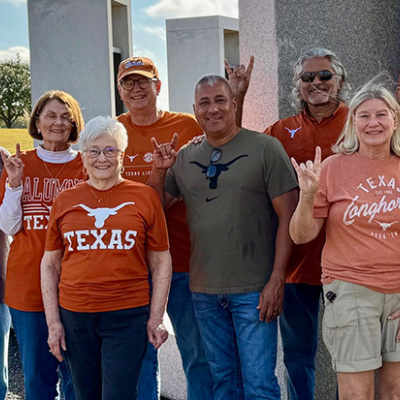Exploring UT’s Underground Network of Tunnels is a Lesson in Energy

It’s harder than you’d think to access a network of forbidden tunnels on the Forty Acres that reside just beneath our feet. And it’s easier than you’d imagine to access one of the largest microgrids in the United States. The key to both is Xavier Rivera Marzán, the executive director of Utilities and Energy Management at The University of Texas at Austin.
UT is one of a growing number of college campuses that are stepping up to the call for greater resiliency and developing microgrids—or localized and self-sufficient energy systems within discrete geographic boundaries—to sustain their power needs. What makes UT unique is that this has been the work of nearly a century.
Our first power plant was built in 1928, and its first generator was installed in 1929. Even then, the utilities management team saw what UT would become. “They knew even then that we could not rely on the existing grid,” Rivera Marzán says. “That we had to be self-sufficient. So they invested in the power plant, and they invested in a distribution system—the tunnels.”
One of the largest microgrids in the United States, the Carl J. Eckhardt Combined Heat and Power plant (CHP) is capable of generating 138 megawatt power and 1.2 million pounds per hour of steam. The single largest electrical load on our main campus is the cooling system that can provide 60,600 tons (38,000 tons peak) of chilled water to the campus. Put simply, CHP provides all utility services to every building on the Forty Acres.
The University buys the water and gas it uses to create energy. The water moves through turbine generators, and any exhaust collected from the turbines passes through a heat recovery steam generator to create heat that warms the water and makes steam. Then, that steam is used again to create more power—a process called cogeneration. This means that, instead of only being 60 percent efficient, CHP is close to 90 percent efficiency in power creation. In layman’s terms, this means that only 10 percent of the energy we buy is discarded as waste.
And below our feet, the series of tunnels, unspooling for miles, ferry this power and water across the Forty Acres. Built in the 1920s, the tunnels represent a feat beyond engineering—they’re also an example of a spirit of forward thinking that is a hallmark of UT’s utilities management team.
Rivera Marzán and his team ensure that mission critical services—such as lab spaces, student dorms and classrooms—remain fully functional regardless of weather conditions. The winter storms in 2021 tested CHP, but the lights stayed on. “There could be any weather event above ground, and there would be continuous protection of our distribution system since it’s underground,” Rivera Marzán says.

When I asked for a tour of these underground tunnels, I received an offer to tour CHP instead. So Rivera Marzán hands my videographer and me squishy green ear plugs on a thin string and leads us through the door into the power plant proper. We first experience a blast of heat, and then a roar of machinery. We’ve stepped onto a large grate that encompasses much of the floor. Brief snatches of the level below flash before our eyes: flickering lights, more machinery, concrete flooring.
Rivera Marzán leads us through the cavernous room, pointing out the combustion turbine and the heat recovery steam generator—both elephantine, filling the space with sound and heat and fury. A control terminal proudly states “Steam generator by Vogt” in curled, mid-century font, although the generator is not that old—it was installed quite recently in 1987. The room contains a mix of old and new that’s jarring. But it’s a mix that may just be the solution to providing energy to campus for lifetimes to come.
“When I’m looking at utilities, I’m looking at it as a chess game,” Rivera Marzán says later, when we’ve left the plant, sweating. “I have to be 15, 20 moves ahead. The decision I’m making now is going to impact us in 20 years and in 50 years.”
The bishops on his chess board are the two boilers the University is currently replacing. The last time they were replaced? In 1969. A World War II–era turbine generator also outfits the University with power. The longevity of these components necessitates forward thinking for utilities management, pushing the boundaries of the future of energy. “We’re not just using our facilities to produce the utilities that we need as a University,” Rivera Marzán says. “We’re also using our facilities as a part of the University’s mission: learning, teaching, and research.”
Ryan Thompson, BS ’03, MS ’06, director of operations at UT’s Utilities and Energy Management (UEM), concurs. “We receive some very unique and insightful questions from students during [tours of the facility],” he says. “It’s inspiring to see the next generation of experts thinking in curious and innovative ways. As a former student here myself, I saw directly how helpful and educational seeing these plants can be.”
Rapid growth across the Forty Acres and beyond brings an exciting new challenge. Coming soon, The University of Texas at Austin and the University of Texas MD Anderson Cancer Center Medical Complex, will increase campus square footage and require reliable utilities. And then there’s the satellite campuses that can fly under the radar in the minds of many Longhorns—the Pickle Research Campus, Montopolis Drive, and the newly acquired UT Taylor land that may one day host semiconductor research.
But there’s world-changing—and then there’s otherworldly.
“Have you ever experienced anything supernatural in the tunnels? Anything you can’t explain?” I ask Rivera Marzán.
He stops to think for a second and pulls out his phone. “You know what?” Rivera Marzán says. “Let me call Leonard.”

Leonard Friesenhahn, BS ’86, arrives—tall, with a warmth and brusqueness that should feel at odds but don’t. Rivera Marzán introduces him as the “owner of the tunnels,” but his real title is associate director of mechanical distribution for UEM. After graduating from the Walker Department of Mechanical Engineering, he has spent his entire 30-plus-year career at UT, with UEM for 23 years.
I ask him about my favorite urban legends. Do the tunnels below UT link to the Texas Capitol Complex? The Capitol has a tunnel system, Friesenhahn says, but they don’t link. Are the tunnels haunted? Just by raccoons. Do the tunnels hide a confidential defense lab and supercomputer? At this, Friesenhahn just laughs.
But we must have struck a chord—been likeable or whimsical or idiotic enough—because Rivera Marzán asks Friesenhahn the million-dollar question: “Can we take them down to see the tunnels?”
Friesenhahn takes us to another building through a maze of restricted access doors. One, monitored at all times by UT security via camera, necessitated him calling and having a brief, tense conversation to get us access. When the last door finally opens, we find ourselves in a small, brightly lit room.
The lighting is harsh and yellow, leaving nothing to the imagination. Pipes of different sizes and shades of silver and rust unwind into faraway darkness, where we’re told not to photograph. Scribblings on the wall look like ancient cave drawings, but they’re notes made by utilities management staff members. Plastic red ribbons are tied off like tiny prayer flags on thin metal wires. A layer of thin dust films the walls.
Seeing it, it’s hard to imagine anything creepy going on down here. And it’s even harder to imagine that this small, cramped space that thousands of people walk above every day but will never see, keep our classrooms lit, our labs air-conditioned, and our bathroom taps on.
“When we talk about sustainability with utilities, it’s not only the tree-hugging side,” Rivera Marzán says. “It’s about the ‘sustain’ part of sustainability ... Are we going to be here in the next hundred years? Are we going to be here in the next 200 years? And how are we preparing for that future?”
CREDIT: Jack Myer (3)





